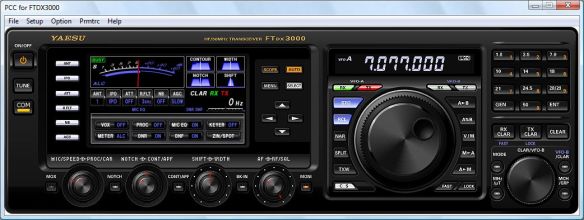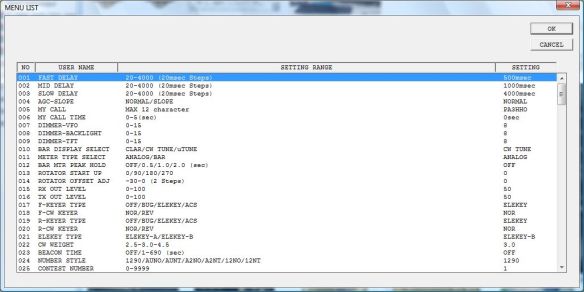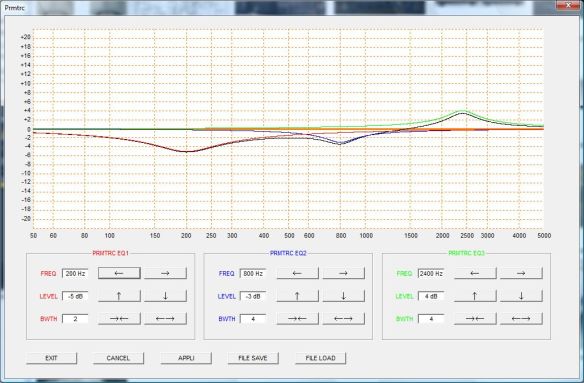My international audience is growing so I’ve decided to continue my blog in English for a while. All that I’ve learned in the music and ham radio hobby, I learned from others all over the world so this is my attempt to contribute to the worldwide ham radio community. With tools as google.translate.com it shouldn’t be too difficult to translate a page in your native language. For my Dutch radio friends: als je iets niet begrijpt, stuur me dan gewoon een mailtje in het Nederlands. Now in German: Ich verstehe Ihre Sprache ganz gut, aber schreiben ist zwierig für mich, bitte haben Sie verständnis.
OK, back to the FTdx-3000 software called PC-3000. In principle, it’s a “virtual” FTdx-3000, if your transceiver is connected to your PC (via RS232 or USB), you can remotely control the radio. I prefer using the radio, but if for some reason you don’t like or simple can’t do so, this might be your thing. It looks pretty nice, almost like the real thing:
Marcus from hamshop.nl warned me about the iffy controls for setting the parameter values; indeed it seems that you need to use cursor key up to decrease the parameter value and vice versa which is ridiculous of course. Luckily, there´s a good workaround because the CLAR/VFO-B dial that I used on the FT-2000 does work as aspected and is handier to use anyway. Still, there are a lot of parameters that can be set. Some people consider that a bad thing (difficult), I don’t. Most of the parameters have a sensible default value so if you don’t want to set any parameters, just don’t do it. Many of the parameters are “set and forget” so you only need to invest a little time once to read the (pretty good) manual, understand what it means and does, set ‘m to your liking and leave ‘m. I like the flexibility of being able to finetune settings as long as it doesn’t complex day-to-day use and it doesn’t so… well done Yaesu!
Because there are so many settings, it is a bit of a struggle to find the parameter you want to set even though they are grouped logically (e.g. “general”, “SSB mode specific”, “CW mode specific”, “display specific” etc.). This is where the PC-3000 software comes in handy. Rather than scrolling through a screen that shows you a single parameter plus value, the PC-3000 software shows a list with parameters from which you can pick the parameter you want to update. Just double click the parameter you want to set, type in or choose the setting and enter. I find it just a little easier to pickup the parms from a list than scrolling through them via the FTdx-3000’s display. Here’s what the parameter window looks like:
Now the GREAT thing about the PC-3000 software; the parametric EQ settings. I tend to think Yaesu either “borrowed” the idea from the 3rd party FT-2000 Remote Control software or maybe they actually bought the code. Well whatever, I love it. The software has a feature to graphically display the effect of your parametric EQ settings. After changing a value, you directly see the impact. I can hear you thinking, why would you want to see it if you should be able to hear it. Well… I’ve found that the audio you hear on your head phones (when monitoring feature is on) differs from the audio that a true receiver “hears”. To be honest, whatever setting you choose, it always sounds pretty nice on the headphones that are connected to the FTdx-3000. On the receiving side, it makes a much bigger impact so sometimes you do need to make some adjustments that you can not hear very well, but the station you’re working can. Let me show you the graphic representation of the parametric EQ settings I use with processor off:
For local rag chewing on 40m, I like nice wideband audio. It took me a while to understand that, when talking about bandwidth, wider is not better. I did experiment with 4kHz semi-wideband transmissions with my previous radios (TS-870 and FT-2000), but I found that the rules for music / studio recording (one of my other hobbies), do not seem to apply to ham radio. I have tried many different microphones from the well known Shure SM58 types to large diaphragm condensor microphones and found that all microphones sounded way too dark when using a wideband setting even though they sound fine on the monitoring head phones. I reckon the transceiver´s preamp is not accountable for this, it must have something to do with the mixer that mixes LF audio with HF. In practice I noticed that wider the spectrum you use (read: the more lows you add), the less high frequencies are mixed in with the HF.
Following is just an educated guess, but I have a feeling DSP “normalizes” the spectrum per frequency band before it´s mixed in. When I used my Rode Procaster with WB setting on the FT-2000, I still had way to much lows even though I drastically reduced the lower frequencies using the parametric EQ: -20db for 100 Hz centre frequency with (very) wide Q (parameter value 1) . Looking at the graphical representation of the parametric EQ, it is obvious that there’s at least 10 dB attenuation from 0 – 200 Hz. When using a normal console mixer, this should result in a very thin mid/high sound. On the FT-2000, it was still a boomy sound with too less highs. If you would look at a normal talking voice using a analyser analyser, you would noticed that mostly mid and high frequencies maybe briefle hit the 0 dB mark. Low frequencies would not be any higher than -10 but probably -20 dB. I think that friggin’ DSP is somehow boosting all individual frequency bands to e.g. -10 dB before it’s mixed in with the HF. Again, this is just an educated guess and probably not all transceivers are doing so (I think Icom does a better job with WB audio), but I am pretty sure something strange is happening with the audio.
Having said that, I have no longer used the wideband setting. The FTdx-3000’s default setting is 300 – 2k8 Hz which had great clarity and probably is the best audible setting but a little more “bottom end” is just a little nicer to listen too so I’m using the 200 – 2k9 Hz setting. As you can see I’m still dipping the lows (center 200 Hz) with a wide Q around 5 dB’s. I also have a smaller Q dip around 900 Hz (the “nasal” spectrum) and I do blend in some spectrum around 2k4 Hz accentuate the “presence” (on a normal mixing console, I would do so by mixing in just a little around 3k5 – 4kHz). I find it hilarious to see people are using advising a 300 – 2k8 Hz bandwidth and then suggesting to decrease the spectrum around 100 Hz. One of the joys of DSP is that, rather then analog filtering, you can be sure NOTHING below 300 Hz is present in your signal after it passes the digital band filter. These parts of the spectrum are litterally thrown away. A lot of people simply don’t seem to grasp the concept of a parametric EQ and the PC-3000 software does help to understand what it actually does. It’s a pitty that the bandwidth or pass band (the spectrum that is passed through the digital bandpass filter) isn’t reflected in the display. The FT-2000 Remote Control software DID so and that was a GREAT feature. May in one of the next updates. I am planning on emailing Yaesu raising these “issues” with them. Again, Icom does a much better job at this some maybe that’s a trigger for Yaesu to have somebody look at the codebase and make some improvements. If you have any questions about this article or the FT-950 / FT-2000 / FTdx-3000 parametric EQ, leave a reply to this page or send me an email.



